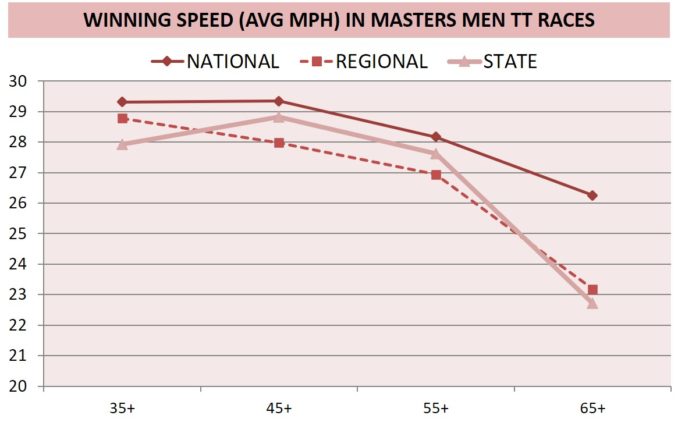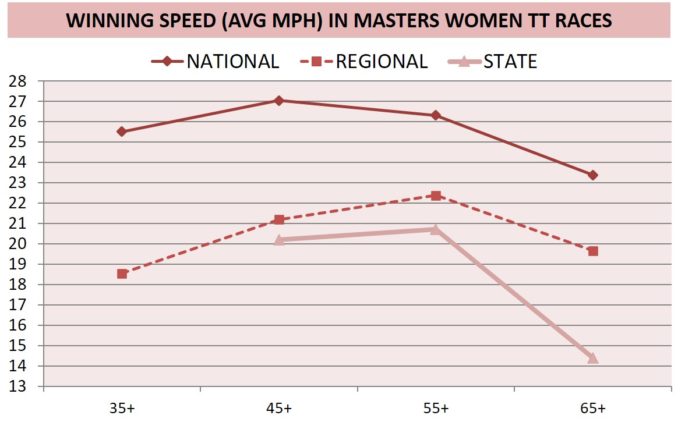Tip #15: If you want to compete, how fast do you have to go?
Obesity levels for the senior population in the U.S. are now over 40 percent. If you are a former high school/college/post-college athlete who has been on the couch for the past 20-30+ years, this series of twice-monthly (1st and 15th of the month) tips will show you how to resume an active lifestyle.
Fortunately, numerous studies have confirmed that it is never too late to resume an active lifestyle. I will show you how to reduce your fitness age, a more reliable indicator of longevity than your BMI, by 20+ years over the next 12-24 months. You will definitely be healthier, happier, and an inspiration for your family, friends, and colleagues. What’s better than that?
If you want to compete, how fast do you have to go?
Maybe, if you are a woman aged 65+ competing at the state or regional level. No, if you are a man in any age-group at any level. Take a look at the winning speeds in the two charts below. Note that men and women race 40 km (24.85 miles) time trials in age-groups from 35-59; 20 km (12.42 miles) time trials in age-groups from 60+. (Some regional and state races don’t switch to 20 km time trials until age 70+.)

 There are a number of caveats to keep in mind when looking at these speeds. Race courses can be flat, rolling hills, or steep hills. Weather conditions can range from hot and humid to freezing cold and windy.
There are a number of caveats to keep in mind when looking at these speeds. Race courses can be flat, rolling hills, or steep hills. Weather conditions can range from hot and humid to freezing cold and windy.If your goal is to win a bike race, or achieve a podium finish, it will take three to five years of time trial-specific training and race experience to increase your speed to these levels.
What have I learned?
When my age-group switched to 20 km races, my average speed increased to 23+ mph. I had one result for 5 km (3.1 miles), and my second victory, at 24.52 mph. To date, I have won local, state, and regional races with an average speed between 23-24 mph. But, this is not fast enough for a national championship.
For example, at the 2017 USA Cycling (USAC) Masters Time Trial Championship, the winning speed in the men’s 65-69 age-group 20 km race was 26.07 mph. The difference between first place (0:28:10:1) and second place (0:28:10.8) was only 0.7 of a second. Incredibly, the time gap between the first and 10th place finisher (0:29:08/25.21 mph) was only 58 seconds. These were undoubtedly some of the fastest age-group competitors in the nation.
At the 2019 USAC Masters Time Trial Championship, the winning speed in the men’s 60-64 age-group (40 competitors) was 27.42 mph; 65-69 age-group (25 competitors) was 27.03 mph; 70-74 age-group (18 competitors) was 26.77 mph; 75-79 age-group (7 competitors) was 24.82 mph; 80-84 age-group (5 competitors) was 23.63 mph; 85-89 age-group (5 competitors) was 21.25 mph; 90-94 age-group (1 competitor) was 22.60 mph.
I have vowed to win a national title even if I have to outlive all of my competitors. That means continuing to race into my 90s, still a couple of decades away.
Any questions?
Tip #16 Preview: What gear do you need to compete?
